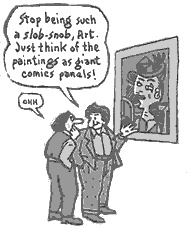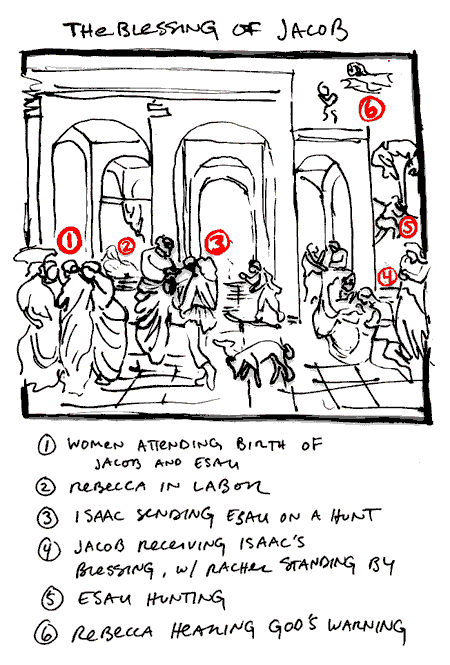
Ever since I saw this bit from Art Spiegelman’s PORTRAIT OF THE ARTIST AS A YOUNG %@?*! where his mentor Ken Jacobs tells a young Art to just think of paintings “as giant comic panels,” I’ve had a new eye towards paintings and all kinds of visual art. I spent a good part of our recent visit to the Art Institue of Chicago thinking, comic…comic…comics!
When I was 20, I had the good fortune to study renaissance art in Florence, Italy for a few summer months. My teacher was Kevin Murphy, an expert on Italian Renaissance Art who teaches at the British Institute of Florence. (His other claim to fame is giving art tours to Mel Gibson whenever Mel’s in town.)
Florence has been my favorite city in the world ever since. (And consequently, Meghan’s, too.)
So I was really excited to hear that three of the newly restored panels from Ghiberti’s “Gates of Paradise” are going to be at the Met while we’re on our honeymoon in New York.
The “Gates of Paradise,” are actually gilded bronze panels on the door to the Battistero di San Giovanni in the Piazza del Duomo:

Their 10 panels depict scenes from the Old Testament, intricately illustrated in high and low relief. When the three-ton, 20-foot-tall doors were completed, in 1452, Michelangelo pronounced them grand enough to adorn the entrance to paradise, and so they became known as “The Gates of Paradise.” They have for centuries been considered one of the masterpieces of Western art.
Of course, it’s impossible for me to not look at those panels and think, “A huge comic!”
Now here’s the bizarre part, courtesy of my old textbook, A. Richard Turner’s Renaissance Art:
We assume that a represented fictive space will contain narrative events understood to be happening simultaneously. For instance, a picture may show several events, say a friar preaching, a man leading a train of donkeys across a square, a fishmonger purveying his wares. We do not necessarily assume that these events have any narrative connection with one another, but because they occupy a common space, we assume they are happening at the same time.
Take a look at the “Isaac” panel from “The Gates”:

At first glance, it looks like a single moment frozen in time, right? Lots of people standing around.
But that’s not what the viewer of the fifteenth century saw, or what the artist intended! What you’re really looking at is the sequence of a story (Isaac’s unintentional blessing of Jacob) spread out across one compositional field, or panel. When you understand the story, the panel can be read sequentially:

Perspective, in this case, isn’t just used to fake the illusion of depth and space: it’s actually used as a storytelling device. So if you look at The Gates as a comic, each panel doesn’t represent a moment of a story, it represents a complete story in itself, and the panels together tell a bigger story.
For some reason, this really blows my mind.
To see more really cool pictures of “The Gates,” check out this site.
yeah, florence rules. and learning art from kevin gave me a much greater respect for a lot of work that i normally would have just glanced over.
oh, yeah! i forgot you went the next year…my cousin is going this summer